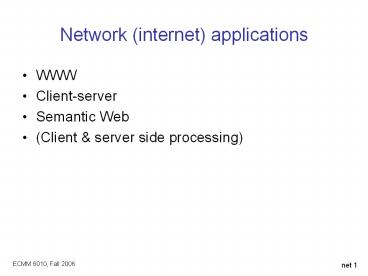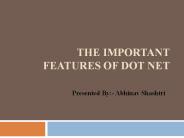net 1 - PowerPoint PPT Presentation
Title: net 1
1
Network (internet) applications
- WWW
- Client-server
- Semantic Web
- (Client server side processing)
2
World Wide Web
Internet
Web server
Borg
Public_html
Index.html
- Parts of the puzzle
- URL
- HTTP
- HTML
Web browser
Your Machine
3
HTTP Hyper Text Transfer Protocol
- Lightweight protocol that browsers and servers
use to communicate with one another - On top of (in the application layer of) the
TCP/IP model - HTTP session begins when a clients browser
requests a Web page. Once the server responds by
sending the page requested, the HTTP session ends
4
GET /index.html HTTP/1.1User-Agent
Lynx/2.4Connection Keep-AliveHost
www.openaccess.comAccept text/html
client request
Server response
HTTP/1.1 200 OKDate Thu, 22 July 1998 184055
GMTServer Apache 1.3.5 (Unix)
PHP/3.0.6Last-Modified Mon, 19 July 1997
160322 GMTContent-Type text/htmlContent-Lengt
h 12987...
MIME type (Multipurpose Internet Mail Extension)
5
HTTP is stateless!!!
- stateless because every request that a browser
makes opens a new connection that is immediately
closed after the document is returned - even a web page with many objects (graphics,
sound, video, etc) requires separate HTTP
requests for each object - each operation is unaware of any other connection
- the server cannot maintain state information
about successive requests easily
6
Client-Server Model
Not mainframe-terminal, not necessarily big vs.
small (rather specialized)
7
Type of servers
- Database servers
- Web servers
- Mail servers
- Print Servers
- Object servers
- Groupware servers
- etc
8
A three-tier architecture
What is middleware?
9
Peer-to-peer vs. Client-Server
- The new hype
- Uniform role of all nodes
- Direct communication
- Decentralized control
- Scalable
10
Web client-server
- Web client (browser) an application program that
runs on a client computer and requests and
displays web pages - can also support other features such as email and
newsgroups - Web server a server-side application program
that runs on a host computer and responds to
requests for web pages
11
Commercial Web browsers
- Statistics from August 20021
- Internet Explorer (96)
- Netscape Navigator (3.4)
- Other browsers (0.6)
- Opera fastest browser
- NeoPlanet - customizable, including skins
- How has IE become such a dominant player in the
browser market?
1Source http//www.statmarket.com/cgi-bin/sm.cgi?
smfeatureweek_stat retrieved Sept. 15, 2002.
12
Web client/server communication
- Like any other client/server application, web
browsers and servers need a way to - Locate each other so they can send requests and
responses back and forth - Uniform Resource Locator (URL)
- Communicate with one another
- Hypertext Transport Protocols (HTTP)
- (See networking section)
13
(X)HTML
- Hypertext Markup Language
- presentation language
- embedded text that tells the clients browser how
to display the page elements - standard formatting language that all browsers
understand - theoretically !
- example tag
- lth1gt ECMM 6000 lt/h1gt
ECMM 6000
14
Interactivity
- HTML is a presentation language not a
programming language - controls the appearance of the information on the
clients screen but does not support processing
or manipulating information - early web browsers were limited to displaying
static pages - But many business applications require
interactivity ? Client-side server-side
processing
15
Thin vs. Fat Clients
- where the processing takes place
- Early browsers were thin clients primary
function was to display web documents containing
text and simple graphics - Todays browsers are not thin, they provide a
great deal of functionality and processing on the
client side - Scripting, active object support, email, web page
authoring, audio, streaming media, Instant
messaging
16
- Web Hub
- Content Management Console
Google News
Admin
XML Content Repository
Retrieve
General Public
Modify
Control Panel
Front End Site
P u b l i c
Modify
Database
Members Section
Alumni
17
TML (XML)
ltthomasgt ltlecture typeearlygt ltopeninggt Gu
ten Morgen lt/openinggt ltmessagegt bla
bla lt/messagegt ltlecturegt ltresearchgt ltpapergt
lt/papergt lt/researchgt lt/thomasgt
18
DTD
lt!ELEMENT ele_name (list of child elements
?)gt Leaf element lt!ELEMENT name
(PCDATA)gt lt!ATTLIST ele_name att_name
att_type att_valuegt lt!ENTITY ent_name
ent_valuegt
19
DTD
XML Document
XML Parser Syntax Validator
valid / not valid
DTD Document
For example MSXML
20
XSLT
XML Document
XSLT Processor
XSL Document
XSLT Document
21
XSLT
Include in XML document lt?xml-stylesheet
typetext/xsl hrefURL ?gt XSLT
document ltxslstylesheet version 1.0
xmlnsxsl url of xslt xmlns url of
xhtmlgt ltxsltemplates match rootgt
lthtmlgt ltheadgt lt/headgt ltbodygt lth1gt
.. ltxslfor-each select taggt
ltspan style whatevergt message lt/spangt
ltxslvalue-of select subtag /gt
ltother html tagsgt . lt/xslfor-eachgt lt/html
gt lt/xsltemplategt lt/xslstylesheetgt
22
Tim Berners-Lee
23
Web service architecture
http//www.w3.org/2002/ws/
Adopted from Clabby, 2002
24
SOAP
- Simple Object Access Protocol
- XML-based protocol
- Exchange of information between applications over
HTTP - Seems to become the widely accepted solution to
electronic data interchange (EDI) and remote
procedure call (RPC, CORBA, etc)
http//www.w3.org/TR/soap12-part0/
25
Latest Web Service Architecture (W3C, 2004)
26
From http//www.w3.org/2001/sw/
Semantic Web The Semantic Web provides a common
framework that allows data to be shared and
reused across application, enterprise, and
community boundaries. It is a collaborative
effort led by W3C with participation from a large
number of researchers and industrial partners. It
is based on the Resource Description Framework
(RDF), which integrates a variety of applications
using XML for syntax and URIs for naming. "The
Semantic Web is an extension of the current web
in which information is given well-defined
meaning, better enabling computers and people to
work in cooperation." -- Tim Berners-Lee, James
Hendler, Ora Lassila, The Semantic Web,
Scientific American, May 2001
27
RDF (Web) Resource Description Framework
Create meaning for automated processing
intelligent agents
http//www.w3.org/TR/rdf-primer/
Web Ontology OWL
http//www.w3.org/TR/owl-features/
Standardized Query Language SPARQL
28
Web Ontology OWL
http//www.w3.org/TR/owl-features/































